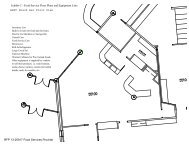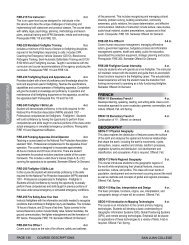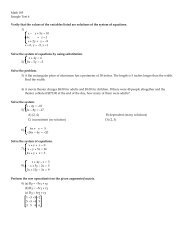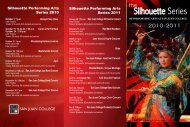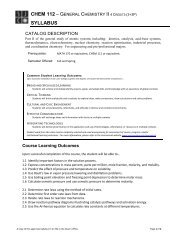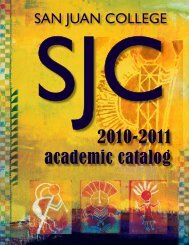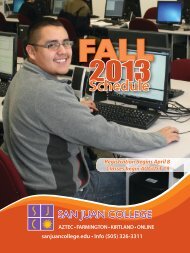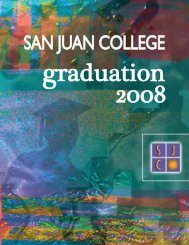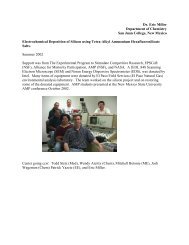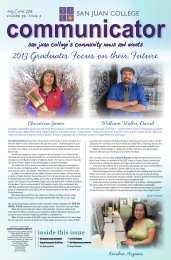AQIP 2007 Systems Portfolio - San Juan College
AQIP 2007 Systems Portfolio - San Juan College
AQIP 2007 Systems Portfolio - San Juan College
Create successful ePaper yourself
Turn your PDF publications into a flip-book with our unique Google optimized e-Paper software.
Percent80%70%60%50%40%30%20%10%0%<strong>San</strong> <strong>Juan</strong> <strong>College</strong> – <strong>AQIP</strong> <strong>Systems</strong> <strong>Portfolio</strong> – November <strong>2007</strong>MATH-095 Learning Community ComparisonFall 2006 and Spring <strong>2007</strong> Combined57.0%Regular66.8%Enrollee Success66.3%LCOMCompleter SuccuessFigure 1.3 SJC Learning Community Comparisons75.0%Figure 1.3 shows the effectiveness of our academicsupport learning communities. Three types of learningcommunities—interdisciplinary, first year experience,and academic support—those that provide additionalsupport for developmental classes offered at SJC.SJC makes every effort to respond to student needs.University Centers, located on the SJC campus, areimportant contributors to the increasing transfer rateto four-year programs. This partnership provides theopportunity for place-bound students in <strong>San</strong> <strong>Juan</strong>County to pursue professional degrees.100090080070060050040030020010001995216Number of Transfers to 4-year Institutions1996303199740019984431999548Figure 1.4 Transfer Trend Data2000574 576YearSJC has processes that allow Schools to pilot andinitiate new courses and programs. The <strong>College</strong> iscommitted to innovative practices, such as learningcommunities and academic support classes.Examples of new courses are as follows:20012002722200382920048842005910• The 105 and 299 course numbering options allowfaculty to put new courses in the schedule andpilot them for two semesters prior to getting fullapprovals from the curriculum committee.• New courses in English, reading, and math thatbetter meet the needs of developmental students.• A process for proposing and supporting learningcommunities that invite faculty from acrosscampus to link a course with another facultymember to provide enriched learning experiencesis in place.• Student satisfaction is measured through multipleinstruments, including student evaluations ofteaching, online evaluations, the small groupfeedback process, occasional focus groups, theCommunity <strong>College</strong> Survey of StudentEngagement (CCSSE) nationally-normed survey,and the Noel-Levitz® Student SatisfactionInventory.• The course scheduling system is flexible andallows for many offerings that depart from thebasic 16 week semester. Courses are offered asshort courses, meeting from 3 to 8 weeks,weekend courses, and other customizedofferings. This flexibility is extended to the onlineand hybrid courses as well.• Benchmarking with other community collegesthrough <strong>San</strong> <strong>Juan</strong>’s participation in the Achievingthe Dream project and the National Community<strong>College</strong> Benchmarking Project has raisedconcerns regarding the progress of studentsenrolled in developmental education classes. Ingeneral, the data reveal that <strong>San</strong> <strong>Juan</strong> has a highproportion of students who need remediation inmathematics and writing, who do not succeed indevelopmental classes in those subjects, and,amongst those who do succeed in thosedevelopmental classes, do not succeed in thefirst college-level course in mathematics orEnglish composition.1R4 SJC involvement with the New Mexico StateAssessment Task Force indicates that the <strong>College</strong> isahead of other state educational institutions in certainareas of assessment. For example, other collegeshave neither identified nor institutionalized commonstudent learning outcomes; similarly, other schoolshave not had as much faculty involvement indeveloping outcomes, rubrics, and processes forartifact assessment.SJC has participated in assessment through theCommunity <strong>College</strong> Survey of Student Engagement(CCSSE) since 2002. SJC uses information providedabout effective educational practices to promoteimprovements in student learning and persistence.Table 1.12 depicts SJC’s performance compared toother medium colleges in 2006 in the five benchmark<strong>AQIP</strong> Category One: Helping Students Learn 11



